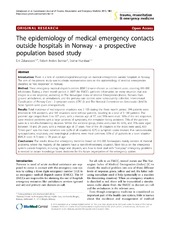| dc.description.abstract | Introduction: There is a lack of epidemiological knowledge on medical emergencies outside hospitals in Norway. The aim of the present study was to obtain representative data on the epidemiology of medical emergencies classified as "red responses" in Norway. Method: Three emergency medical dispatch centres (EMCCs) were chosen as catchment areas, covering 816 000 inhabitants. During a three month period in 2007 the EMCCs gathered information on every situation that was triaged as a red response, according to The Norwegian Index of Medical Emergencies (Index). Records from ground ambulances, air ambulances, and the primary care doctors were subsequently collected. International Classification of Primary Care - 2 symptom codes (ICPC-2) and The National Committee on Aeronautics (NACA) Score System were given retrospectively. Results: Total incidence of red response situations was 5 105 during the three month period. 394 patients were involved in 138 accidents, and 181 situations were without patients, resulting in a total of 5 180 patients. The patients' age ranged from 0 to 107 years, with a median age of 57, and 55% were male. 90% of the red responses were medical problems with a large variation of symptoms, the remainder being accidents. 70% of the patients were in a non-life-threatening situation. Within the accident group, males accounted for 61%, and 35% were aged between 10 and 29 years, with a median age of 37 years. Few of the 39 chapters in the Index were used, A10 "Chest pain" was the most common one (22% of all situations). ICPC-2 symptom codes showed that cardiovascular, syncope/coma, respiratory and neurological problems were most common. 50% of all patients in a sever situation (NACA score 4-7) were > 70 years of age. Conclusions: The results show that emergency medicine based on 816 000 Norwegians mainly consists of medical problems, where the majority of the patients have a non-life-threatening situation. More focus on the emergency system outside hospitals, including triage and dispatch, and how to best deal with "everyday" emergency problems is needed to secure knowledge based decisions for the future organization of the emergency system. | en_US |

